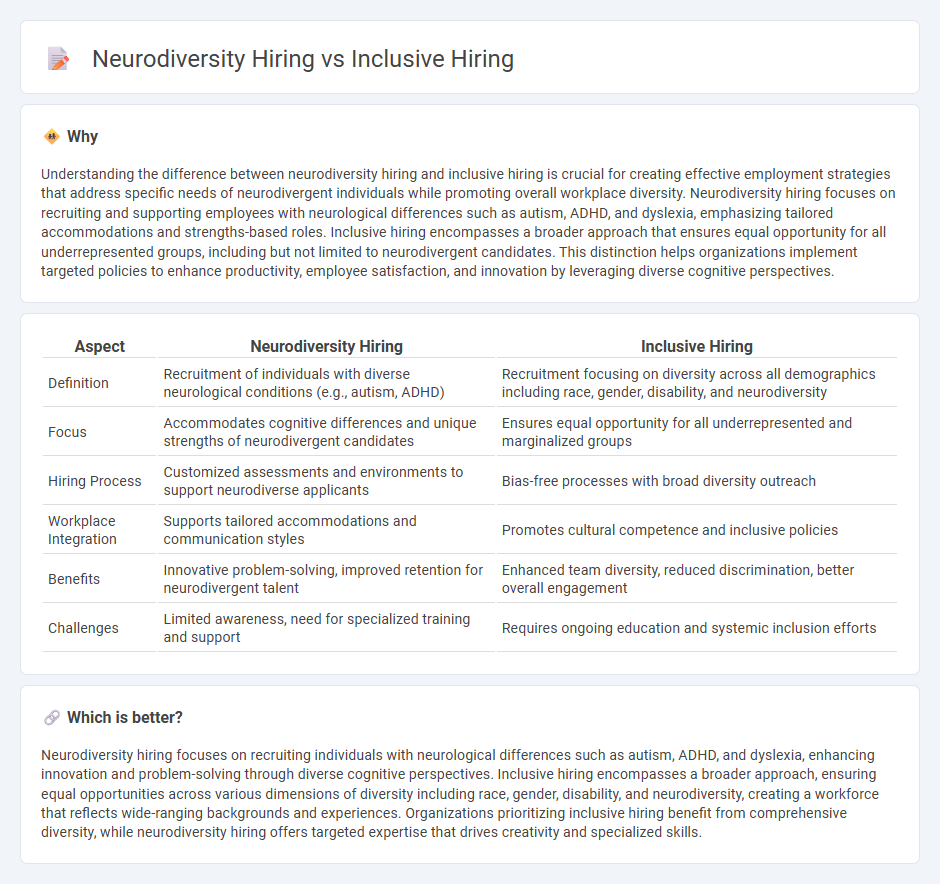
Neurodiversity hiring focuses on recruiting individuals with neurological differences such as autism, ADHD, and dyslexia, emphasizing unique cognitive strengths and tailored support. Inclusive hiring encompasses a broader range of diversity dimensions including race, gender, disability, and age, promoting equitable access and workplace belonging for all. Explore effective strategies to implement both neurodiversity and inclusive hiring for a dynamic and innovative workforce.
Why it is important
Understanding the difference between neurodiversity hiring and inclusive hiring is crucial for creating effective employment strategies that address specific needs of neurodivergent individuals while promoting overall workplace diversity. Neurodiversity hiring focuses on recruiting and supporting employees with neurological differences such as autism, ADHD, and dyslexia, emphasizing tailored accommodations and strengths-based roles. Inclusive hiring encompasses a broader approach that ensures equal opportunity for all underrepresented groups, including but not limited to neurodivergent candidates. This distinction helps organizations implement targeted policies to enhance productivity, employee satisfaction, and innovation by leveraging diverse cognitive perspectives.
Comparison Table
| Aspect | Neurodiversity Hiring | Inclusive Hiring |
|---|---|---|
| Definition | Recruitment of individuals with diverse neurological conditions (e.g., autism, ADHD) | Recruitment focusing on diversity across all demographics including race, gender, disability, and neurodiversity |
| Focus | Accommodates cognitive differences and unique strengths of neurodivergent candidates | Ensures equal opportunity for all underrepresented and marginalized groups |
| Hiring Process | Customized assessments and environments to support neurodiverse applicants | Bias-free processes with broad diversity outreach |
| Workplace Integration | Supports tailored accommodations and communication styles | Promotes cultural competence and inclusive policies |
| Benefits | Innovative problem-solving, improved retention for neurodivergent talent | Enhanced team diversity, reduced discrimination, better overall engagement |
| Challenges | Limited awareness, need for specialized training and support | Requires ongoing education and systemic inclusion efforts |
Which is better?
Neurodiversity hiring focuses on recruiting individuals with neurological differences such as autism, ADHD, and dyslexia, enhancing innovation and problem-solving through diverse cognitive perspectives. Inclusive hiring encompasses a broader approach, ensuring equal opportunities across various dimensions of diversity including race, gender, disability, and neurodiversity, creating a workforce that reflects wide-ranging backgrounds and experiences. Organizations prioritizing inclusive hiring benefit from comprehensive diversity, while neurodiversity hiring offers targeted expertise that drives creativity and specialized skills.
Connection
Neurodiversity hiring and inclusive hiring intersect by recognizing and valuing diverse cognitive abilities, fostering workplace environments that accommodate different thinking styles such as autism, ADHD, and dyslexia. Inclusive hiring practices integrate neurodiverse candidates by adapting recruitment processes, offering tailored support, and promoting equity, which enhances innovation and productivity. Both approaches contribute to creating diverse talent pools and improving organizational culture through acceptance and accommodation of neurological differences.
Key Terms
Equal Opportunity
Inclusive hiring emphasizes providing equal opportunities to all candidates regardless of background, ensuring fairness in recruitment processes. Neurodiversity hiring specifically targets the inclusion of individuals with neurological differences such as autism, ADHD, and dyslexia, recognizing their unique strengths and capabilities. Explore how integrating neurodiversity hiring can enhance your organization's commitment to equal opportunity and innovation.
Reasonable Accommodations
Inclusive hiring emphasizes creating a workplace welcoming to all individuals, including those with disabilities, by implementing reasonable accommodations such as flexible work hours and adaptive technologies. Neurodiversity hiring specifically targets recruiting and supporting individuals with neurological differences like autism and ADHD by offering tailored accommodations that leverage their unique strengths. Explore how integrating these approaches can transform your organization's talent strategy and promote a truly accessible work environment.
Cognitive Diversity
Inclusive hiring practices prioritize a workforce that reflects diverse backgrounds, abilities, and perspectives, fostering an equitable workplace culture. Neurodiversity hiring specifically champions the recruitment of individuals with neurological differences, such as autism, ADHD, and dyslexia, to harness unique cognitive strengths and problem-solving abilities. Explore how focusing on cognitive diversity through tailored recruitment strategies can drive innovation and business growth.
Source and External Links
What is inclusive hiring? - Greenhouse - Inclusive hiring is the practice of minimizing bias and creating equitable application, interview, and selection processes through structured tactics such as writing inclusive job descriptions, blind resume screening, and standardized interviews to ensure fairness for diverse candidates.
How to Build Inclusive Hiring Practices - SHRM - Inclusive hiring involves not only attracting diverse talent by training hiring managers and creating unbiased job descriptions but also fostering a culture of inclusion through mentorship, leadership examples, and ongoing improvement of hiring practices.
Inclusive Hiring Best Practices: Building Opportunities for All - Qualtrics - Inclusive hiring begins well before recruitment by developing an environment of growth for everyone and showcasing diverse role models to encourage underrepresented groups toward broader career opportunities within an organization.
 dowidth.com
dowidth.com